Owls, enigmatic and nocturnal birds of prey, captivate the imagination with their mysterious allure and distinctive characteristics.
Belonging to the order of Strigiformes, these fascinating creatures are renowned for their exceptional hunting prowess and remarkable adaptations for nocturnal life.
With large, forward-facing eyes, specialized for low light conditions, and keen hearing facilitated by facial discs, owls are expert nocturnal hunters, silently swooping down on unsuspecting prey.
Their feathers, designed for silent flight, contribute to their stealthy approach, making them masters of the night sky. Owls exhibit a diverse range of species, each possessing unique physical traits and habitats, from the petite Elf Owl to the majestic Great Horned Owl.
Revered across various cultures for their symbolic significance, owls continue to intrigue and inspire, embodying the mystique of the nighttime realm in the vast tapestry of the avian world.
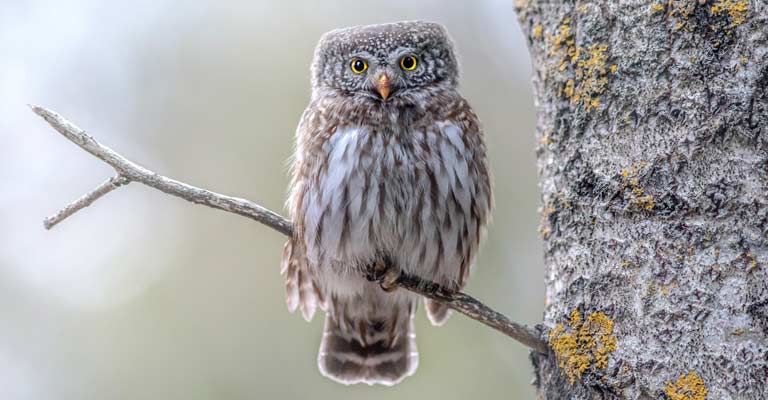
Physical Characteristics of Owls
Owls possess a distinctive set of physical characteristics that make them easily identifiable within the avian kingdom. These remarkable birds of prey exhibit adaptations that enhance their nocturnal lifestyle and superb hunting abilities.
Here are eight key points to help identify these enigmatic creatures:
Facial Discs and Large Eyes

One of the most striking features of owls is their unique facial discs, comprised of specialized feathers arranged in a circular pattern around their eyes.
These discs function like satellite dishes, funneling sound to their ears and aiding in precise hearing. Owls boast disproportionately large, forward-facing eyes, adapted for low light conditions, granting them exceptional night vision.
Nocturnal Adaptations
Owls are primarily nocturnal, and their physical characteristics reflect this lifestyle. Their eyes are designed with a high number of rod cells, which are sensitive to low levels of light, allowing them to see in almost complete darkness.
Additionally, the arrangement of their retinal cells enhances their ability to detect motion, a crucial advantage during night-time hunting.
Silent Flight Feathers

Owls are renowned for their silent flight, a trait achieved through specialized wing and feather structures.
The leading edges of their flight feathers have serrated edges, reducing turbulence and minimizing the noise generated during flight. This adaptation enables them to approach their prey stealthily without alerting it to their presence.
Distinctive Feather Patterns
Each owl species exhibits unique feather patterns and colors that aid in their identification.
From the iconic heart-shaped facial disc of the Barn Owl to the cryptic camouflage of the Eastern Screech Owl, these patterns play a crucial role in their survival, helping them blend seamlessly into their respective environments.
Powerful Talons and Beaks

Owls are equipped with strong, curved talons adapted for grasping and subduing their prey. Their powerful grip is complemented by a sharp, hooked beak, which they use to tear and consume their catch.
The variations in beak size and shape among different owl species reflect their diverse dietary preferences.
Head Rotation Ability
Owls possess an extraordinary ability to rotate their heads up to 270 degrees, allowing them to scan their surroundings without moving their bodies.
This flexibility compensates for their fixed eye sockets, enabling them to maintain a keen vigilance over their territory and detect potential threats or prey.
Distinctive Calls and Hoots

Each owl species has a unique vocalization, ranging from haunting hoots to sharp screeches.
These calls play a vital role in communication, especially during mating rituals and territory establishment. The diversity of owl vocalizations further aids in species identification.
Size and Physical Build

Owls exhibit a range of sizes, from the petite Elf Owl, measuring around 5 inches, to the majestic Great Horned Owl, with a wingspan exceeding 4 feet.
Their physical build, including body shape, size, and feather tufts (ear tufts or “horns”), varies among species, contributing to their overall distinctive appearance.
The identification of owls involves a comprehensive understanding of their unique physical adaptations, from facial discs and silent flight feathers to distinctive calls and hunting tools.
Recognizing these features enhances our appreciation for these magnificent birds and their remarkable place in the natural world.
Taxonomical Information of Owls
The taxonomy table delineates the classification of the specified bird within the biological hierarchy.
Belonging to the domain Eukaryota and kingdom Animalia, it falls under the phylum Chordata, class Aves, and the Telluraves clade. The bird is formally categorized in the order Strigiformes, as established by Wagler in 1830.
Notably, it comprises two families: Strigidae and Tytonidae. This table succinctly outlines the hierarchical structure that defines the taxonomic position of this avian species in the broader spectrum of biological classification.
Here’s the taxonomy table for the bird based on the provided information:
| Taxonomic Level | Classification |
| Domain | Eukaryota |
| Kingdom | Animalia |
| Phylum | Chordata |
| Class | Aves |
| Clade | Telluraves |
| Order | Strigiformes, (Wagler, 1830) |
| Families | Strigidae, Tytonidae |
Subspecies of Owls
There are a lot of subspecies of Owls. Here are the sub-species described briefly:
Whiskered Screech Owl

A diminutive owl with distinct facial “whiskers,” the Whiskered Screech Owl inhabits the woodlands of North and South America. Its camouflage plumage and haunting calls characterize this elusive species.
Puerto Rican Owl

Endemic to Puerto Rico, this rare owl species features a reddish-brown plumage. Its nocturnal habits and preference for dense forests contribute to its elusive nature.
Flammulated Owl

A small owl found in North America’s coniferous forests, the Flammulated Owl is recognized for its reddish-brown plumage and distinctive hoots, often heard during summer nights.
Oriental Scops Owl

Inhabiting diverse habitats across Asia, the Oriental Scops Owl is a compact species with excellent camouflage. Its piercing calls resonate through the night, reflecting its nocturnal lifestyle.
Snowy Owl

Renowned for its striking white plumage, the Snowy Owl thrives in Arctic tundra habitats. Adapted to polar environments, it is a powerful predator, with keen eyesight and swift hunting skills.
Great Horned Owl

One of North America’s largest owls, the Great Horned Owl boasts distinctive ear tufts and a robust build. An adept predator, it preys on a wide range of creatures, showcasing its adaptability.
Eastern Screech Owl

With a diverse range of colors, from red to gray, the Eastern Screech Owl is a small owl species found in North America. Its haunting screeches and nesting habits in tree cavities define its behavior.
Barred Owl

Recognized by its distinctive hooting calls, the Barred Owl is a medium-sized owl inhabiting forests across North America. Its brown plumage, marked with vertical bars, contributes to its cryptic appearance.
Western Screech Owl

A small owl inhabiting western North America, the Western Screech Owl showcases various color morphs, blending into its surroundings. Its haunting trills and adaptable nature contribute to its survival in diverse habitats.
Spotted Owl

Occupying old-growth forests of North America, the Spotted Owl is recognized by its dark eyes and distinctive spots on its plumage. This nocturnal hunter faces conservation challenges due to habitat loss.
Mottled Owl

Native to Central and South America, the Mottled Owl features intricate mottled patterns on its plumage. Its haunting calls echo through the tropical forests where it resides, contributing to its mysterious aura.
Burrowing Owl

A diurnal owl species, the Burrowing Owl nests in burrows and displays distinctive long legs. Found in open landscapes, this owl is recognized for its bobbing head movements and ground-dwelling habits.
Elf Owl

The smallest owl in North America, the Elf Owl, thrives in arid regions, utilizing tree cavities for nesting. Its diminutive size and high-pitched calls contribute to its charm in the southwestern United States.
Ferruginous Pygmy Owl
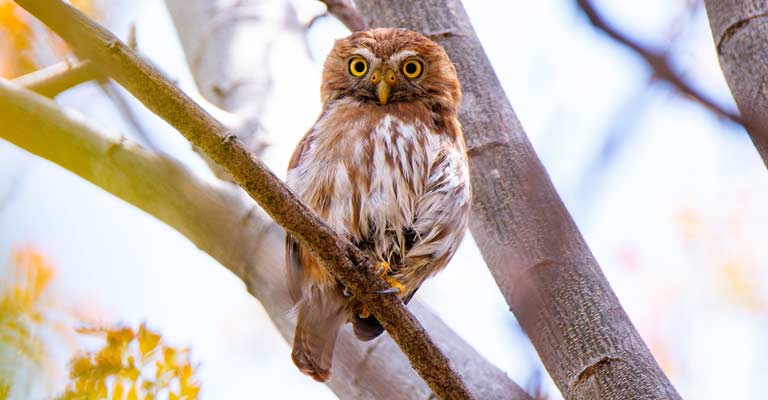
Inhabiting parts of Central and South America, the Ferruginous Pygmy Owl is characterized by its small stature and reddish-brown plumage. Its daytime activity and bold demeanor set it apart in its tropical habitats.
Northern Pygmy Owl
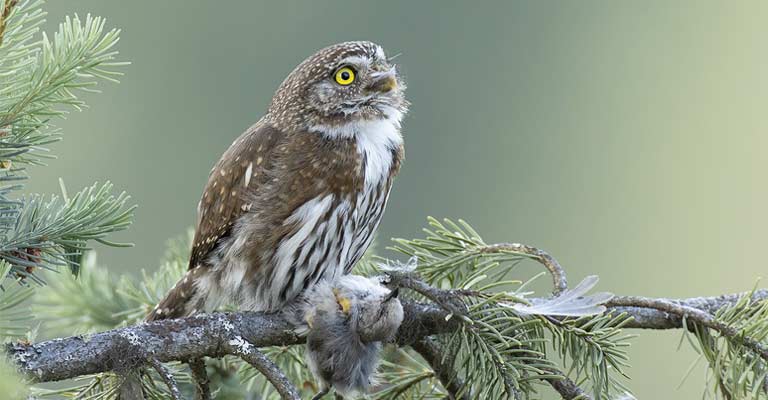
A compact owl found in North America, the Northern Pygmy Owl possesses a distinctive “false face” pattern on its back. Agile and diurnal, it preys on small birds and mammals, showcasing impressive hunting skills.
Northern Hawk-Owl

Residing in boreal forests, the Northern Hawk-Owl is diurnal and adept at hovering. Recognized by its hawk-like appearance, it preys on small mammals, showcasing exceptional hunting skills.
Northern Boobook

Found in northern regions, the Northern Boobook is a compact owl with distinctive facial markings. Its haunting calls punctuate the night, echoing through the dense forests it calls home.
Northern Saw-whet Owl
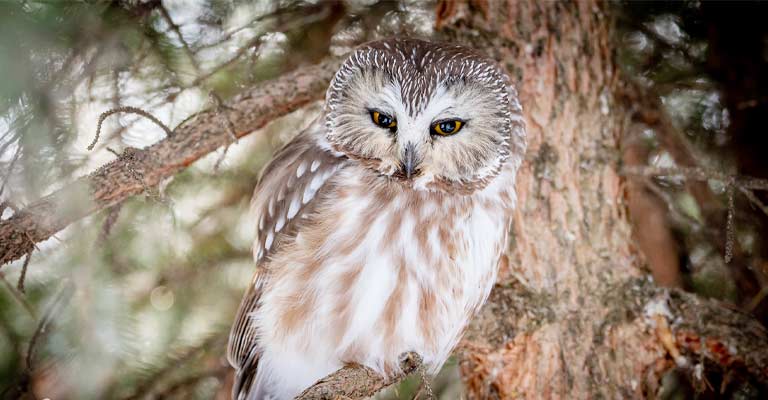
With a unique saw-like call, the Northern Saw-whet Owl is a small, nocturnal species. Its compact size and mottled plumage provide effective camouflage in coniferous and mixed woodlands.
Boreal Owl

Inhabiting northern forests worldwide, the Boreal Owl is characterized by its dark eyes and spotted plumage. Its haunting calls resonate through the evergreen forests where it preys on small mammals.
Short-eared Owl

Active during daylight hours, the Short-eared Owl is known for its distinctive facial disk and short tufts. Thriving in open landscapes, it engages in aerial displays during courtship.
Stygian Owl
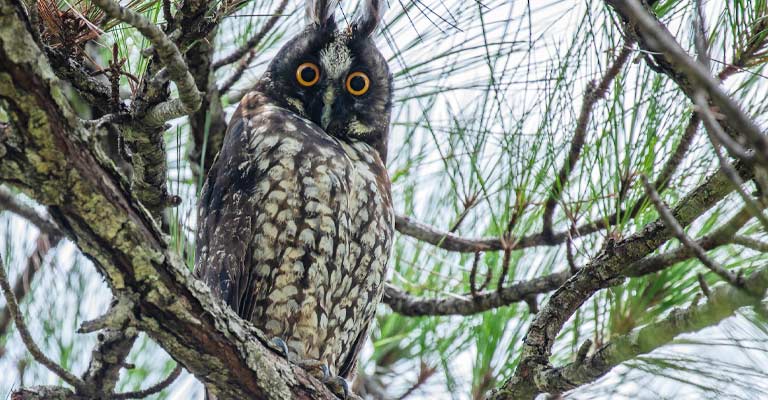
Inhabiting tropical forests, the Stygian Owl is recognized by its large size and dark plumage. Its deep hoots and elusive nature contribute to its mysterious presence in Central and South America.
Long-eared Owl

Preferring woodlands and open areas, the Long-eared Owl has prominent “ear” tufts and a mottled appearance. Nocturnal and elusive, it relies on stealth to hunt small mammals.
Great Grey Owl

Among the largest owl species, the Great Grey Owl resides in northern forests. Recognized by its large facial disk and grey plumage, it is an expert hunter, relying on its keen senses in low-light conditions.
Owl Life History
Owls, enigmatic and nocturnal birds of prey, have a captivating life history shaped by their remarkable adaptations and survival strategies.
From their diverse habitats to intricate nesting behaviors, owls navigate a world that intertwines with both the shadows of night and the delicate intricacies of their ecosystems.
Food
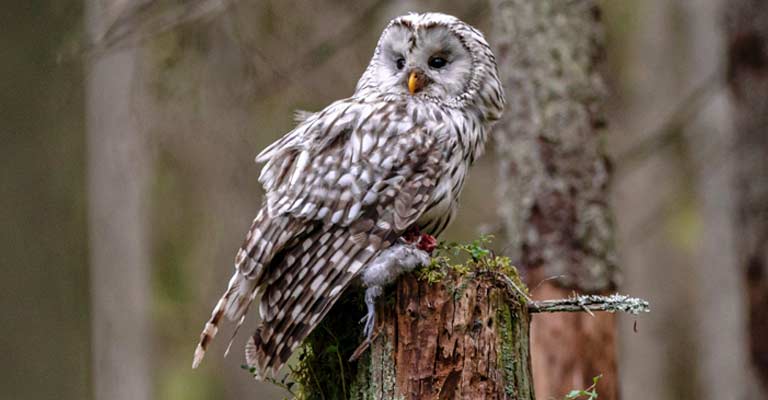
Owls exhibit versatile dietary preferences, feeding predominantly on small mammals like mice, rats, and voles. Some larger species, such as the Great Horned Owl, may prey on rabbits and even other birds.
The Silent flight and powerful talons of owls enable them to be efficient hunters, employing keen senses to locate and catch prey under the cover of darkness.
Habitat
Owls occupy a wide range of habitats, from dense forests to open grasslands, adapting to diverse ecosystems worldwide.
Each species selects a niche that aligns with its specific requirements, emphasizing the significance of undisturbed territories for their survival.
Range Map

The distribution of owls spans across continents, with various species exhibiting unique range maps. Their presence is intricately connected to the availability of suitable prey and nesting sites, illustrating the delicate balance within ecosystems.
Nesting

Owls are meticulous nesters, often utilizing tree cavities, abandoned nests, or even constructing nests on the ground. The choice of nesting sites varies among species, reflecting adaptations to local environments.
The female takes charge of incubating eggs, while the male provides food, ensuring the survival of their offspring.
Here are all the details of their nesting habits in a table:
| Nesting Details | Facts |
| Clutch Size | Varies by species; typically 1 to 6 eggs |
| Number of Broods | Usually 1 per breeding season |
| Egg Length | Ranges from 1 to 3 inches (2.5 to 7.6 cm) |
| Egg Width | Varies between 1 to 2 inches (2.5 to 5 cm) |
| Incubation Period | Approximately 20 to 40 days, depending on species |
| Nestling Period | Typically 20 to 50 days, varying by species |
| Egg Description | White or slightly tinted, spherical to elliptical shape |
| Nest Type | Utilizes tree cavities, abandoned nests, or constructs ground nests |
| Nest Material | Lined with feathers, leaves, and other soft materials |
| Parental Involvement | Female incubates eggs; both parents care for nestlings |
| Nest Location | Varies, including trees, cliffs, and burrows |
| Nest Defense | Aggressive behaviors to deter potential threats |
| Fledgling Independence | Offspring become independent after leaving the nest |
Breeding

Breeding seasons vary, with some owls favoring winter months and others nesting during warmer periods. Courtship rituals involve elaborate displays, vocalizations, and the exchange of food offerings.
The resulting offspring undergo a period of growth and development under the watchful eyes of their parents.
Diseases
Owls, like all wildlife, are susceptible to diseases that can affect their overall health and reproductive success.
Avian diseases, such as aspergillosis, impact their respiratory systems, while parasites may also pose threats. Monitoring and understanding these health issues are crucial for effective conservation efforts.
Treatment
Conservationists and wildlife rehabilitators play a crucial role in treating injured or diseased owls.
Rehabilitation centers provide medical care, rehabilitation, and release programs to ensure the well-being and survival of these magnificent birds. Collaboration with experts in avian medicine contributes to the development of effective treatment strategies.
Conservation

Owls face various conservation challenges, primarily stemming from habitat loss, human encroachment, and environmental pollutants.
Conservation efforts focus on preserving critical habitats, implementing sustainable land-use practices, and raising awareness about the importance of these nocturnal predators in maintaining ecological balance.
In essence, the life history of owls is a fascinating journey intricately woven into the fabric of their ecosystems.
From the silent flights in pursuit of prey to the meticulous care given to their offspring, owls embody nature’s delicate intricacies and the importance of safeguarding these extraordinary birds for generations to come.
5 Fun Facts About Owl
Owls, mysterious nocturnal hunters, have long captured human fascination with their enigmatic behavior and unique adaptations. Here are five fun facts about these remarkable birds:
- Silent Flight: Owls possess specialized wing feathers that allow them to fly silently. This adaptation aids in surprise attacks on prey, with their wing structure minimizing the sound of air rushing over their wings.
- Facial Expressions: Unlike most birds, owls have a fixed eye position within their sockets. To compensate, they’ve developed highly flexible necks, capable of rotating up to 270 degrees. This ability gives them an almost comical range of facial expressions, reinforcing their reputation for wisdom and intensity.
- Asymmetrical Ear Placement: Owls have asymmetrical ear openings on their heads, one higher than the other. This unique arrangement enables precise localization of sounds and aids in their exceptional hunting accuracy.
- Unique Calls: Each owl species has distinct vocalizations, from hoots to screeches, used for communication and mate attraction. The haunting calls contribute to the mystical aura surrounding these nocturnal birds.
- Pellets and Digestion: Owls regurgitate indigestible parts of their prey, such as bones and fur, in the form of pellets. These pellets provide valuable insights for researchers studying owl diets and play a crucial role in their digestive process.
Wrapping Up
The world of owls is a tapestry woven with remarkable adaptations, mysterious behaviors, and vital ecological roles. From their silent nocturnal flights to the intricate nuances of nesting and hunting, owls embody the enigmatic beauty of the avian realm.
As guardians of ecosystems, their significance extends beyond their charismatic presence, influencing both cultural narratives and scientific understanding.
Conservation efforts must continue to safeguard these captivating birds, ensuring their habitats remain undisturbed and their unique contributions to biodiversity endure.
Owls, with their silent wisdom and fascinating life history, invite us to delve deeper into the intricate complexities of the natural world, fostering an appreciation for the delicate balance that sustains these extraordinary creatures.